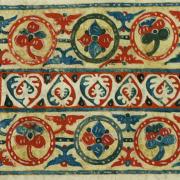Byzantine bindings are the traditional bindings of Greek manuscripts from the medieval period to the seventeenth century. Indeed, the term "Byzantine" refers to the technique and this type of binding. Byzantine scholars have provided much of the texts of Greek culture that exist today. The work of Byzantine scholars and writers made during the long period of their influence was therefore essential for cultural transmission. Collections of Greek manuscripts are found mainly in Western Europe (but also in Russia and the Middle East) in the great libraries and monasteries. These collections represent between 50 and 60,000 manuscripts, but only a small portion of these retain their ancient bindings. We find bindings of Byzantine type throughout the area of Byzantine cultural influence – on Syriac, Arabic, Cyrillic manuscripts – and we also find them on manuscripts from neighboring regions, especially on Coptic, Ethiopian, Georgian and Armenian bindings.
Project activities:
Activity I: Workshops on contemporary bookbinding
These workshops will provide places for the creation of contemporary bindings inspired by Byzantine techniques and will produce facsimiles of bindings, representative of various production types (Constantinopolitan, Cretan, Athonite, etc). These workshops will be followed by several exhibitions showing the bindings created in the workshops, and videos and e-learning tools will be made available online.
Activity II: Interdisciplinary missions to observe Greek and Byzantine bindings.
These missions aim to develop exchanges between specialists in historical Greek manuscripts (researchers, curators, conservators, students ...), to promote the study of collections of manuscripts and bindings in Europe and to disseminate information collected from these manuscripts.
Activity III: Development of a common European protocol for the study and description of Byzantine bindings.
The objective of this activity is to bring together specialists in Greek manuscripts in order to stimulate cooperation between them and their institutions and develop common methods of observation, e.g. photographic methodology. The final result of this activity will be the production of a reference document standardizing the descriptions of Byzantine bindings.
Activity IV: International seminars on the characteristics of Byzantine bindings and their conservation.
The seminars will be places at which knowledge and expertise on the study of Byzantine manuscripts is exchanged and at which the activities carried out in the project are presented. Their goal will be to raise public awareness of heritage preservation.
Organizers:
Centre de Conservation du Livre (France) - Lead partner
National Hellenic Research Foundation (Greece)
SIVECO (Romania)
Biblioteca Academiei Romane (Romania)
Laterna Magica (Hungary)
International Academis Projects (United Kingdom)
EURelations GEIE (Italy)
Years: 2011-2013
Supporters:





















